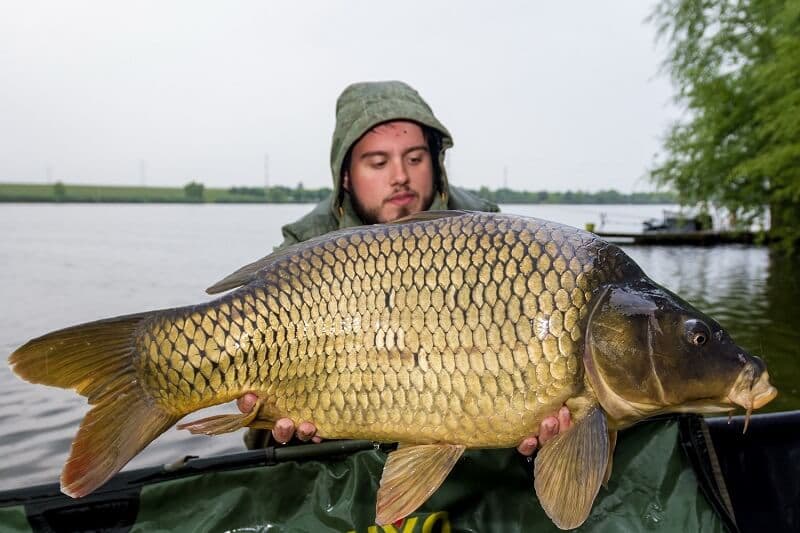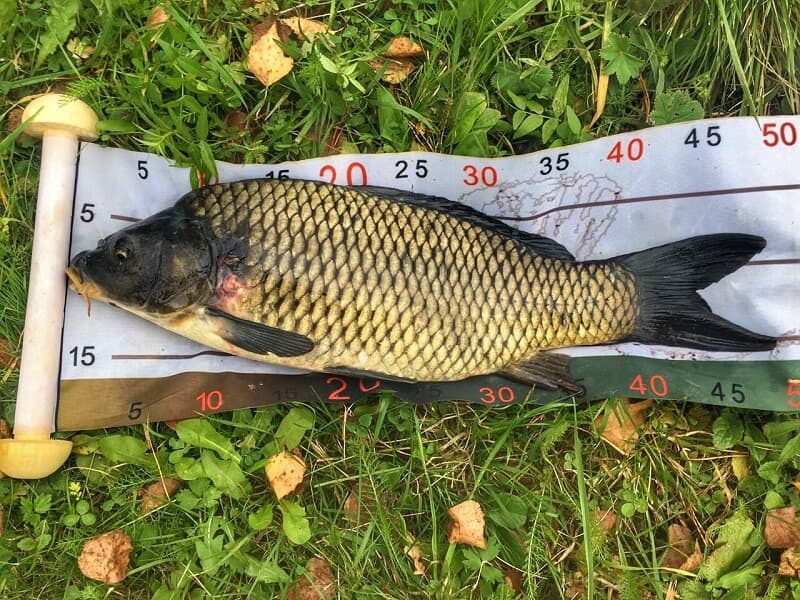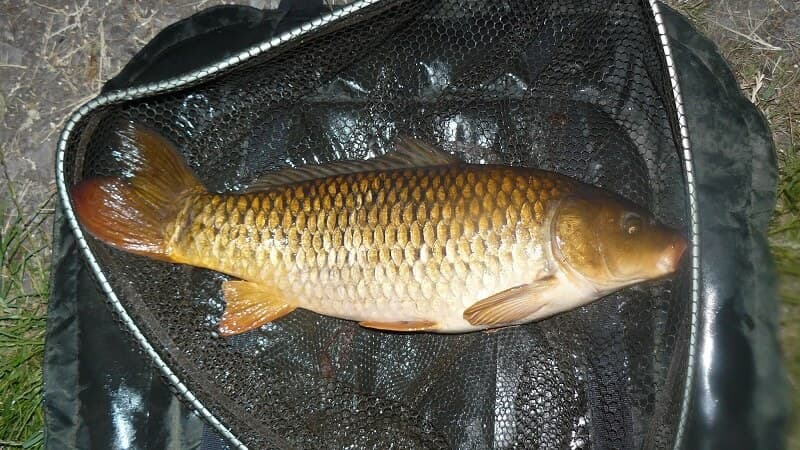Contents
Catching carp for many anglers is the only chance to hook something worthwhile. In autumn, this fish is distinguished by good size, confident bite. However, it is more difficult to find it than in summer, and it is caught only before the onset of cold weather. carp fishing in autumn has a number of features, which this article will tell you about.
Features of autumn carp fishing
As you know, carp are heat-loving fish. Its behavior is highly dependent on the temperature of the water. It can change depending on the weather outside, and especially if there are night frosts. These usually lead to a sharp decrease in water temperature, even if the weather is sunny during the day. As soon as thin ice shores appear on the reservoir, you can almost always forget about autumn carp fishing.
The most reliable indicator of the autumn bite of carp is a water thermometer. Before you go fishing, you should measure the temperature of the water, if not at the place of fishing, then at least in a nearby reservoir, where the weather conditions are similar. It is not subject to daily fluctuations as much as air temperature, so it can be measured at any time of the day. However, the most accurate indicators will be obtained in the morning, since at this time it is minimal.
If, with such measurements, the water turns out to be cooled below ten degrees, then you can forget about any carp fishing. As a last resort, if you don’t want to cancel your fishing trip, you can use carp gear to try to catch crucian carp if it lives there. The fact is that with the onset of cold weather, this fish clogs in deep places where the water temperature is relatively constant. Carp stay there until warming, practically not eating. During wintering, the carp is covered with a thick layer of protective mucus, which saves immobile individuals from the penetration of bacteria.
Therefore, any talk about catching carp in November, as well as catching it in March, can be called into question. Such fishing is possible only where the water temperature is abnormally warm. However, many combine business with pleasure – during tourist trips to Cyprus, Turkey, Egypt, there is an opportunity to catch carp, which almost never hibernates. There is, however, little information about such fishing, but they catch it on the same float and bottom gear as in Russia.
First of all, small individuals of this fish fall into hibernation. The largest ones remain active the longest. Fish food at this time is made up of various aquatic insects, worms, sometimes newts and larger aquatic inhabitants. Although the carp also eats fry on occasion, catching it on a spinning rod is a casual activity. There may be carp bites when catching a predator, but they are rare. However, when catching a small perch, what a pleasure it is to catch a trophy weighing 15 kilograms on a thin tackle and pull a stubborn fish out of the water!

The right choice of bait
Carp in our latitudes almost refuses plant food in autumn. The fact is that he needs high-calorie food that does not require much effort to digest. Both in bait and as a bait, it is highly recommended to add something alive that moves and attracts fish not only by smell. By the way, the last factor when fishing in autumn water is no longer as significant as when fishing in warm water in summer. In cold water, odors spread much more slowly than in warm water. Smelly bait is no longer able to attract fish so much from a long distance. However, the fact that it is able to hold carp well, which has come up for bait, should not be denied, and it cannot be completely abandoned either.
As a rule, autumn carp is a single large fish. You can wait a long time for several days, patiently throwing a bait to the place where it can be, and finally catch it. In the southern latitudes, this fish reaches a solid size – up to 20 kilograms. Usually the largest individuals are a subspecies of the mirror or naked carp, and not the wild carp carp.
the ercal subspecies also takes root better in more northern latitudes, where you can often find abandoned carp with the remaining carp. For example, there are old collective farm ponds in the Smolensk region, in the Moscow region, in the Leningrad region, where you can catch a large mirror carp. Unfortunately, due to the cooling of the water, fishing for it in these places ends the earliest. Also, this fish in unprotected ponds usually quickly becomes a prey for poachers.
In more southern regions, where the water temperature is higher, you can fish in October, and November carp fishing is not uncommon here. Often they catch carp when fishing for silver carp, which has taken root well here. It has similar habits, but is rarely seen together and does not have mixed packs. Where one fish is caught, it is rare to find another.
Classic carp fishing in autumn
Classical or English carp fishing in autumn is usually carried out in still water or in a very weak current. In places where the current is stronger, it is almost impossible to use a marker float, especially at great depths. As a rule, you can meet carp on large lakes with a cold snap only at a considerable distance from the coast. There, the water usually does not cool as quickly as near the coast.
It is necessary to clearly determine the distance from the coast, where the water will cool more at night. The fact is that all coastal life with cooling also rushes to the depths, but not too far. Therefore, at this temperature boundary, where the depth is already sufficient so that the water does not cool to the very bottom, but not very far from the coast, its greatest concentration will be. Small aquatic fauna attracts carp most of all, and there it should be looked for.

Fishing for a fee
On paid reservoirs the situation is somewhat different. Usually the fish there, even in the summer, are overfed and react to the nozzle thrown by the angler only in a very short time of the day. It affects not only this, but also stress. The fish in the paysites is usually imported, and it takes about a week for it to survive the stress of travel and acclimatize. Only then does it begin to actively feed, but immediately these individuals are usually caught by anglers.
In general, a healthy carp, if it has not fallen into a state of hibernation, eats almost around the clock. Neither the weather, nor precipitation, nor the phases of the moon, nor any other climatic phenomena, except for the cooling of the water, can have a strong influence on its biting. You can fish with equal success in the morning, afternoon and evening. The activity of biting decreases only at night, when visibility in the water is poor due to darkness and the carp loses orientation in space and appetite for a short time.
In autumn, only neutral bait compositions with the addition of pellets, the animal component, are used for carp tackle. No provocative smells or colors – only neutral dark colors. Autumn carp are large, cautious and have a slow metabolism – hunger cannot prevail over discretion. You can catch boilies, but here they will not stand out so much against the background of worms, maggots and other animal baits. Of course, fishing with carp tackle for a worm will be unconventional, but it can bring success, and you must be prepared to put the worm on the hook in the absence of bites or use one of your fishing rods under the worm.

Fishing on canals, straits
It is much easier to catch carp in canals and channels in autumn. This is a semi-anadromous or anadromous carp. It follows from spawning grounds and summer fattening places to wintering pits. He usually does not stay long in one place, even when walking in a pack. Bait when catching such fish is not very effective, and catching carp in such places cannot be considered classic. However, in narrow channels, the probability of meeting fish at one point is much higher than looking for it in the vast territory of a lake, bay or pond.
Carp fishing here can take place using a slightly different technology. Usually “carp” places near the coast are overgrown with reeds. Approaching the place of fishing, where the water has an open mirror of the channel, should be in the knee pads. The rod also often has to be placed on elaborate stands to keep the reel out of the water. Usually it is installed almost vertically on a special rack.
The casting distance for such fishing is usually small, they feed the fish from their hands. They learn about a bite by triggering a signaling device. Most often it is a bell, but sometimes electronic and other signaling devices are used. Fishing is usually carried out with no more than three or four rods of a shortened type, up to two meters. Such fishing is popular in many southern regions of Russia and is not so expensive compared to full-fledged English carp fishing. It is used both on small rivers and canals, and on eriks in the lower reaches of the Volga and the Urals, where you can find a sufficient number of carp in the fall. On equipment, however, it is not worth saving here. Although the rods themselves are simpler and there are fewer of them, but good hair equipment, good hooks and fishing line are the key to a good catch.
Bottom line fishing
You can adapt the feeder and bottom gear for carp fishing. Usually, when fishing on a feeder, you have to deal with much smaller trophies than a full-fledged half-pound carp. It is worth taking care of a good solid rod and a quality fishing line. The line in carp fishing is not used so often and only in cases where it is required to carry out long-range casting with a shock leader. It is much easier to examine the bottom, the water temperature and identify places where carp can stay closer to the shore and there is no need for long-distance casting. This will allow you to use a lighter rod with a line that will absorb the jerks of large fish.
Fishing with bottom tackle usually does not have the nature of sport fishing. Often used here are snaps of two hooks, which are spaced with a nozzle like a hair snap. Naturally, such tackle excludes fishing on a catch-and-release basis. They fish both on donks with a rod and on hooks without a rod. The usual places for autumn fishing for such tackle are those where it can also be cast not too far. They are baited when fishing on the bottom from the hand, bait in the feeder is not used so often.
Catching a feeder
Feeder is the only sports tackle that can be used to successfully catch carp on large rivers with a current. It allows you to qualitatively explore the bottom, determine its sections, drops, promising places where carp can stay. For example, on the Volga, carp can be found in autumn in ditches that run along the coast. Usually enough food accumulates there, and he eats it willingly. Sometimes, with sufficient depth, these same places are wintering pits. It is caught here as a settled carp, not moving along the river during its life, and semi-anadromous.
Feeder fishing involves the use of a universal rod both for feeding fish and for catching and exploring the bottom. Of course, with such tackle it is impossible to throw a significant amount of food at the fishing point in a short time, but this is not required in the fall – the amount of bait here should not be too large. In feeder fishing for carp, elements of carp tackle are often used – hair equipment, a method feeder, boilies, etc.

You can catch both this way and with classic feeder tackle, since an ordinary metal cage feeder is more effective in the current. It is able to quickly deliver food to the bottom and not scatter it in the water column when immersed. Unfortunately, such a feeder excludes the use of pellets in bait, and the classic carp spod is more suitable for them, which is too heavy for a feeder. The use of a spod feeder for feeding requires the use of a feeder of a class not lower than heavy, even with small weights of a sinker, a small current and a small casting distance.
Fishing on a float
Autumn float fishing for carp from the shore is practically not carried out. Of course, such fishing is much more spectacular and emotional than bottom fishing. However, starting from September, fish begin to move to ever deeper places. It becomes almost impossible to reach them with a float rod if you do not use a boat.
But the boat in the autumn is able to scare away the cautious large carp. The fact is that visibility and audibility in the water in autumn are very good, especially in stagnant water. If the boat is made of metal or wood, the fish can hear walking on the boat far away, and the carp may simply not come up. Using a rubber boat in cold water is quite dangerous, because you can simply get too cold and not swim to the shore in case of a puncture of the cylinder, even if the second one is afloat.
There you can walk on it to the right place, without risking scooping up water with your boots, tying it among the vegetation and calmly fishing. She finds enough food in eriks, in addition, the depth there can reach such values that the water at the bottom will not cool too quickly during the night, and the fish can stay there all the time. A fish is much less afraid of a boat that stands in the reeds than one that stands in the middle of open water.
However, it is worth saying that carp are most effectively caught on a float not in autumn, but immediately after spawning. Then it’s easier to get to him, and he pecks more actively. A float rod for carp fishing is especially good in overgrown areas, in shallow water, in windows among aquatic vegetation, where it is simply impossible to use a donk. In the spring, yes, carp can be found more often in such places. Closer to autumn, it is easier to catch it on a bottom bait.










